A High-Resolution Open Source Platform for Building Envelope Thermal Performance Assessment Using a Wireless Sensor Network
Abstract
1. Introduction
- Thermal resistance and conductivity from the surface to surface of both sides of the material.
- Thermal transmittance from the environment to the environment of both sides of the material.
- The thermal properties of the materials being tested and the heat transfer coefficient need to be constant over the entire measurement region.
- The heat stored in the materials is negligible compared to the amount of heat that moves through the materials.
- The temperature difference between indoors and outdoors is at least 10 ℃.
- The wind speed is less than 3 m/s.
- The heat flow sensor is shielded against direct exposure to solar radiation and moisture.
- The measurements are non-continuous and non-real-time since the collected data have to be processed offline. Thus, any inconsistency in measurements cannot be observed and efficiently corrected during the measurement.
- The equipment is bulky, hardwired, and consumes a significant amount of power.
- Image interpretation is usually challenging.
- Proper environmental conditions have to be met to ensure that external factors, such as wind, solar radiation, and moisture, do not interfere with the measurements.
- It cannot be easily integrated within other platforms.
2. Thermal Performance Measurement
- Ambient air temperature on both sides of the walls, noted as Te and Ti with units of K (Kelvin)
- The surface temperature on both sides of the walls, noted as Tse and Tsi with units of K (Kelvin)
- Heat flux through the walls (envelope), whose density is noted as Φ with units of W/m2.
3. System Description
3.1. Sensor Nodes
- More sensors can be added into the sensor nodes without additional hardware in the gateway node. Only minor software modifications are required.
- More sensor nodes using the same communication protocols can be deployed.
- The setup and calibration for all nodes are performed and stored locally.
3.2. Gateway/Coordinator Node
4. Experiment Setup and Results
- When one node fails, it will not affect other parts of the network.
- It facilitates adding or removing nodes in the network.
- Easy monitoring of the network since all nodes are managed by the gateway node.
- More channels are required because each node is connected directly to the gateway.
- Since the entire network depends on the gateway, if the gateway fails, the entire network goes down.
- The capacity of the gateway determines the performance and number of nodes that can be accommodated by the network.
5. Discussion
- The system is able to collect and process data in real-time.
- The system can be customized to take any number of measurements with any time interval, as per the requirements of the user or the specifications of the measurement.
- Using the same gateway (the coordinator node), different measurements within the distance of 100 m indoors or 1.2 km outdoors can be accommodated.
- These measurements can be accessed remotely in any place through the Internet, and the gateway can also be reconfigured remotely when needed.
- A connection to the Internet can be easily initiated through Wi-Fi or a cable connection.
- The developed system is accurate, cheap, and small in size.
6. Conclusions
Author Contributions
Funding
Conflicts of Interest
References
- Rasooli, A.; Itard, L.; Ferreira, C.I. A response factor-based method for the rapid in-situ determination of wall’s thermal resistance in existing buildings. Energy Build. 2016, 119, 51–61. [Google Scholar] [CrossRef]
- Sujatmiko, W.; Suhedi, F.; Rumiawati, A. Thermal resistance measurements of building envelope components of the minang traditional house using the heat flow method. In Proceedings of the 2016 International Seminar Sensors, Instrumentation, Measurement Metrology ISSIMM, Malang, Indonesia, 10–11 August 2016; pp. 88–92. [Google Scholar]
- Sassine, E. A practical method for in-situ thermal characterization of walls. Case Stud. Therm. Eng. 2016, 8, 84–93. [Google Scholar] [CrossRef]
- Echarri, V.; Espinosa, A.; Rizo, C. Thermal transmission through existing building enclosures: Destructive monitoring in intermediate layers versus non-destructive monitoring with sensors on surfaces. Sensors 2017, 17, 2848. [Google Scholar] [CrossRef] [PubMed]
- Asdrubali, F.; D’Alessandro, F.; Baldinelli, G.; Bianchi, F. Evaluating in situ thermal transmittance of green buildings masonries: A case study. Case Stud. Constr. Mater. 2014, 1, 53–59. [Google Scholar] [CrossRef]
- Lamrani, M.; Laaroussi, N.; Khabbazi, A.; Khalfaoui, M.; Garoum, M.; Feiz, A. Experimental study of thermal properties of a new ecological building material based on peanut shells and plaster. Case Stud. Constr. Mater. 2017, 7, 294–304. [Google Scholar] [CrossRef]
- El Azhary, K.; Chihab, Y.; Mansour, M.; Laaroussi, N.; Garoum, M. Energy Efficiency and Thermal Properties of the Composite Material Clay-straw. Energy Procedia 2017, 141, 160–164. [Google Scholar] [CrossRef]
- Derbal, R.; Defer, D.; Chauchois, A.; Antczak, E. A simple method for building materials thermophysical properties estimation. Constr. Build. Mater. 2014, 63, 197–205. [Google Scholar] [CrossRef]
- International Organization for Standardization. Building Components and Building Elements. In Thermal Insulation: Determination of Steady-State Transmission Properties, Calibrated and Guarded Hot Box; ISO Standard 8990; International Organization for Standardization: Geneva, Switzerland, 2007; Available online: https://www.iso.org/obp/ui/#iso:std:iso:8990:ed-1:v1:en (accessed on 15 November 2019).
- International Organization for Standardization. Thermal Insulation, Building Elements. In Situ Measurement of Thermal Resistance and Thermal Transmittance; Part 1: Heat Flow Metre Method; ISO Standard 9869-1; International Organization for Standardization: Geneva, Switzerland, 2014; Available online: http://www.iso.org/iso/catalogue_detail.htm?csnumber =59697 (accessed on 15 November 2019).
- Lucchi, E. Applications of the infrared thermography in the energy audit of buildings: A review. Renew. Sustain. Energy Rev. 2018, 2018, 3077–3090. [Google Scholar] [CrossRef]
- International Organization for Standardization. Building Components and Building Elements. In Thermal Resistance and Thermal Transmittance; Calculation Method; ISO Standard 6946; International Organization for Standardization: Geneva, Switzerland, 2007; Available online: https://www.iso.org/obp/ui/#iso:std:iso:6946:ed-2:v1:en (accessed on 15 November 2019).
- Márquez, J.M.A.; Bohórquez, M.Á.M.; Melgar, S.G. A new metre for cheap, quick, reliable and simple thermal transmittance (U-Value) measurements in buildings. Sensors 2017, 17, 9. [Google Scholar]
- Frei, M.; Hofer, J.; Schlüter, A.; Nagy, Z. An easily-deployable wireless sensor network for building energy performance assessment. Energy Procedia 2017, 122, 523–528. [Google Scholar] [CrossRef]
- Kylili, A.; Fokaides, P.A.; Christou, P.; Kalogirou, S.A. Infrared thermography (IRT) applications for building diagnostics: A review. Appl. Energy 2014, 134, 531–549. [Google Scholar] [CrossRef]
- Fox, M.; Goodhew, S.; De Wilde, P. Building defect detection: External versus internal thermography. Build. Environ. 2016, 105, 317–331. [Google Scholar] [CrossRef]
- Texas Instruments, ADS1115. Available online: http://www.ti.com/lit/ds/symlink/ads1115.pdf (accessed on 4 January 2020).
- Mouser, Atmega328P-PU. Available online: https://www.mouser.co.uk/datasheet/2/268/ Atmel-8271-8-bit-AVR-Microcontroller-ATmega48A-48P-1315288.pdf (accessed on 4 January 2020).
- DIGI, XBee®/XBee-PRO/S2C Zigbee. Available online: https://www.digi.com/resources/ documentation/digidocs/pdfs/90002002.pdf (accessed on 4 January 2020).
- RaspberryPi Org, Raspberry Pi 3 Model B. Available online: https://www.raspberrypi.org/products/raspberry-pi-3-model-b-plus/ (accessed on 4 January 2020).
- phpMyAdmin, Bringing MySQL to the Web. Available online: https://www.phpmyadmin.net/ (accessed on 29 February 2020).
- Measurement Specialities, HTM2500LF–Temperature and Relative Humidity Module. Available online: https://docs.rs-online.com/fcd5/0900766b8142cdce.pdf (accessed on 4 January 2020).
- Wood, C. Thermal Performance of Historic Windows. 2012. Available online: https://www. buildingconservation.com/articles/thermal/thermal.htm (accessed on 4 January 2020).
- Designing Buildings Ltd., U-values. Available online: https://www.designingbuildings.co.uk/wiki/U-values (accessed on 4 January 2020).



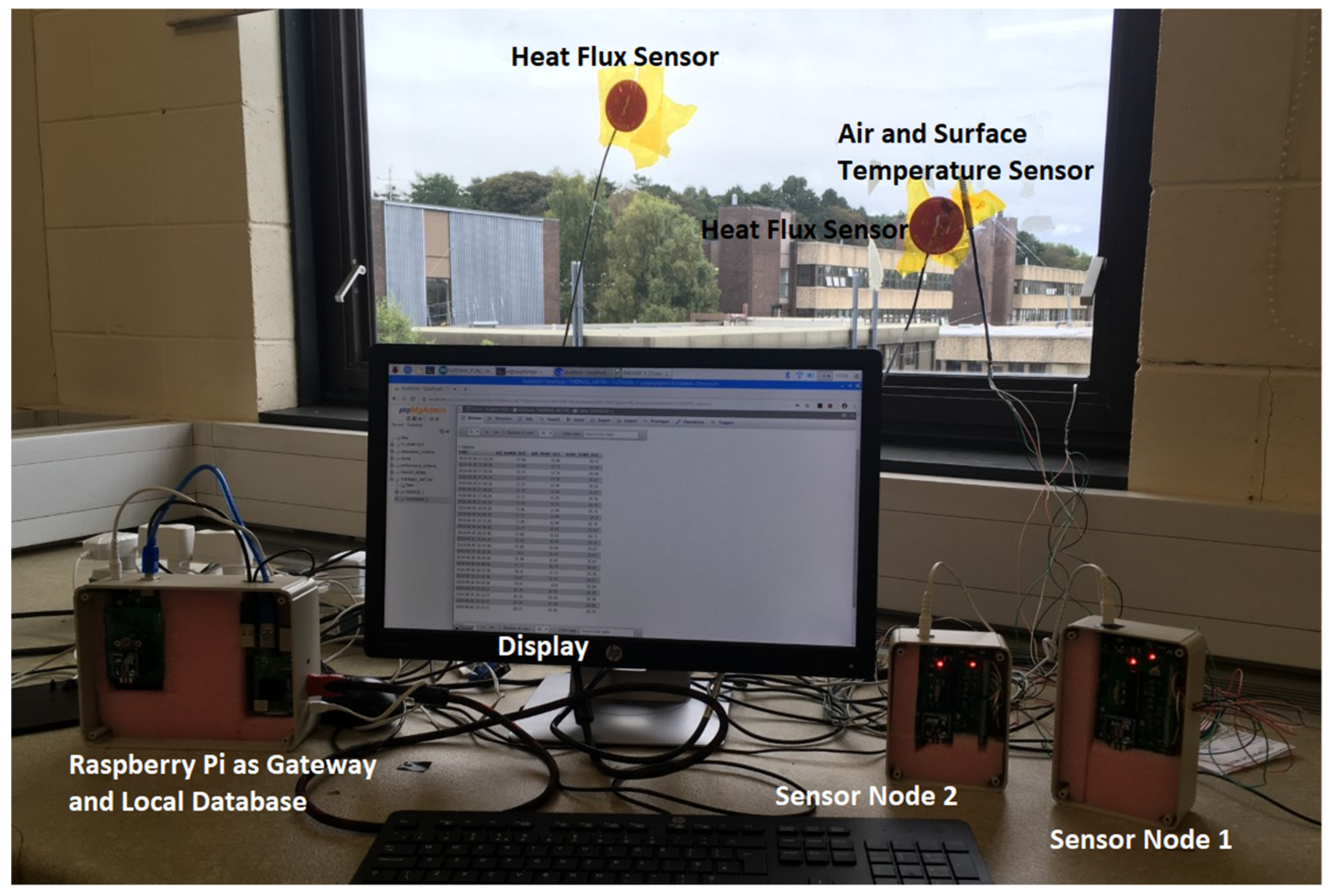
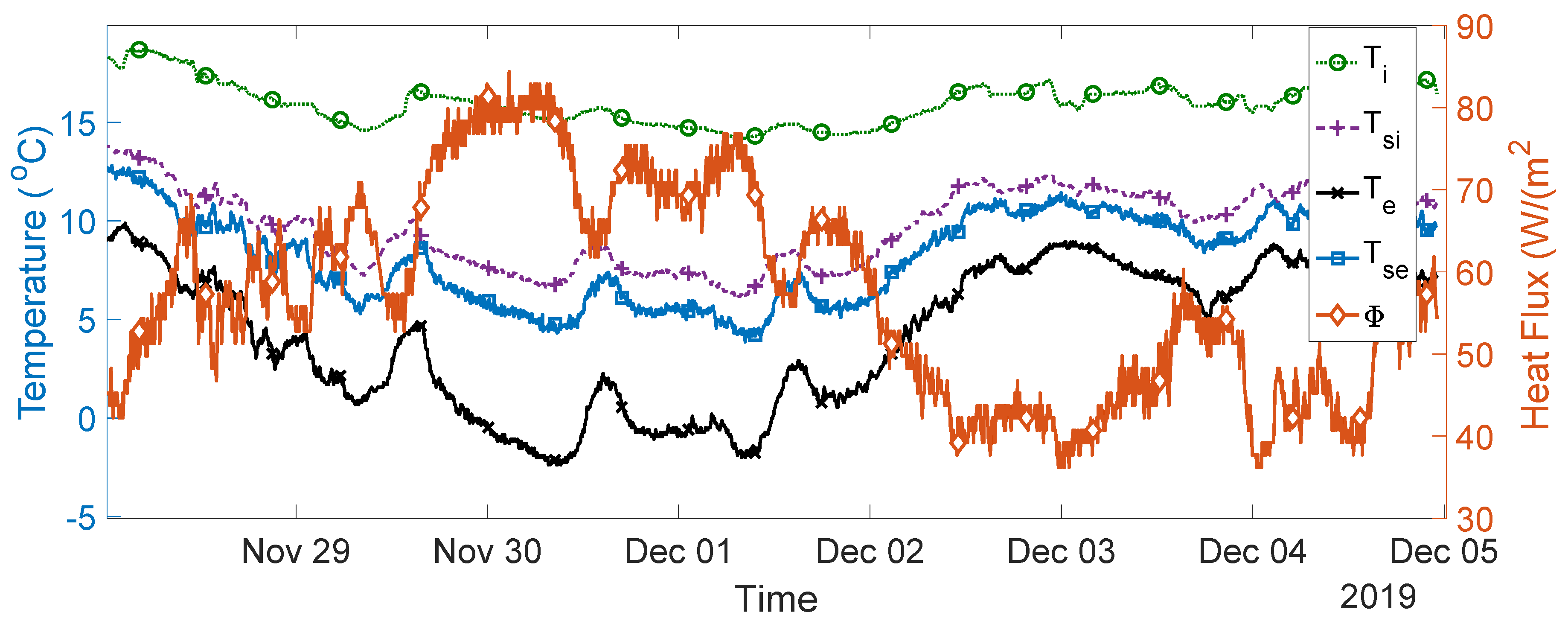
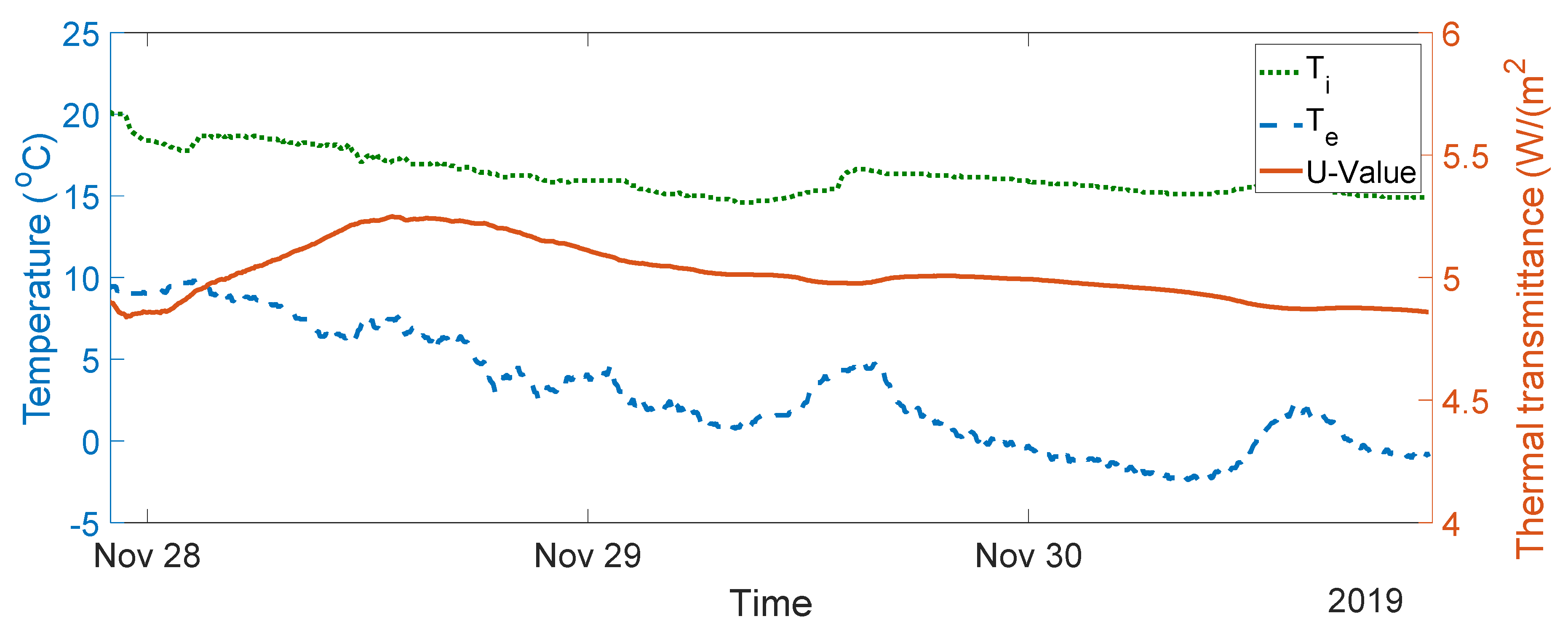
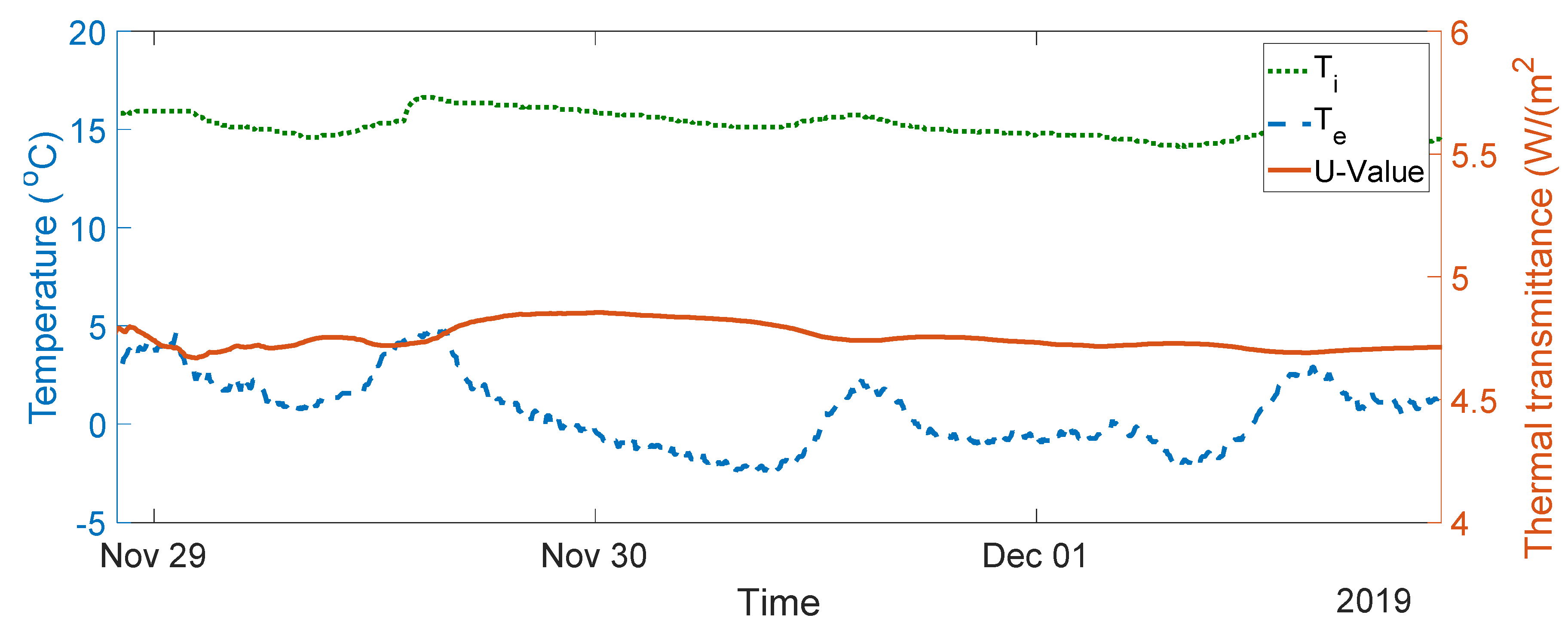

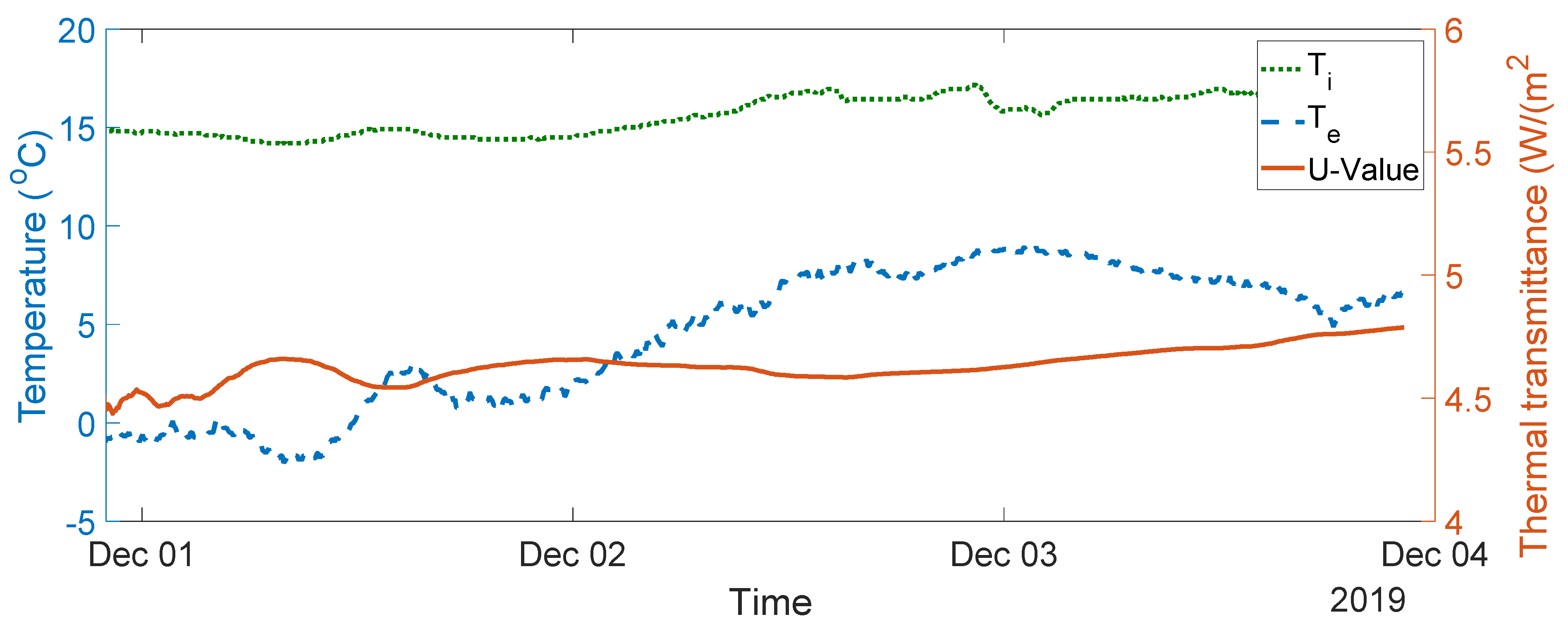
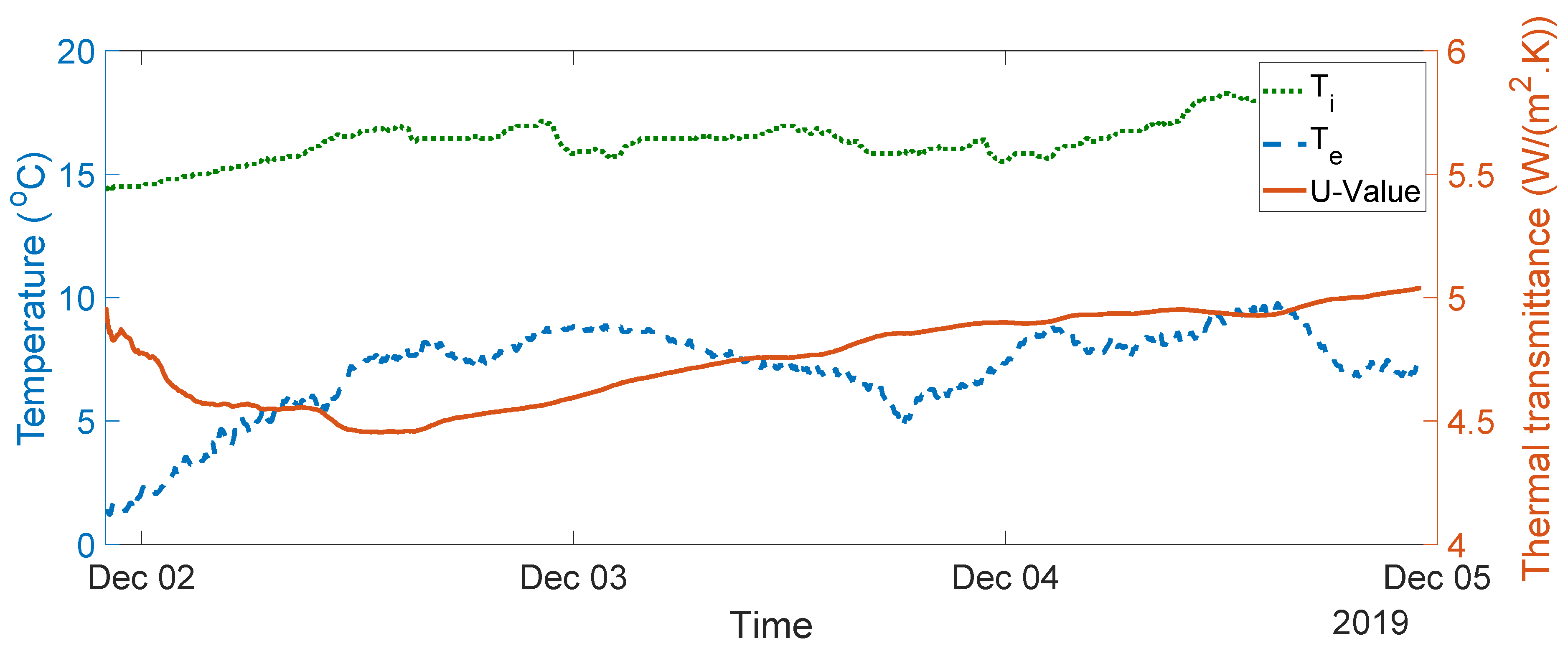

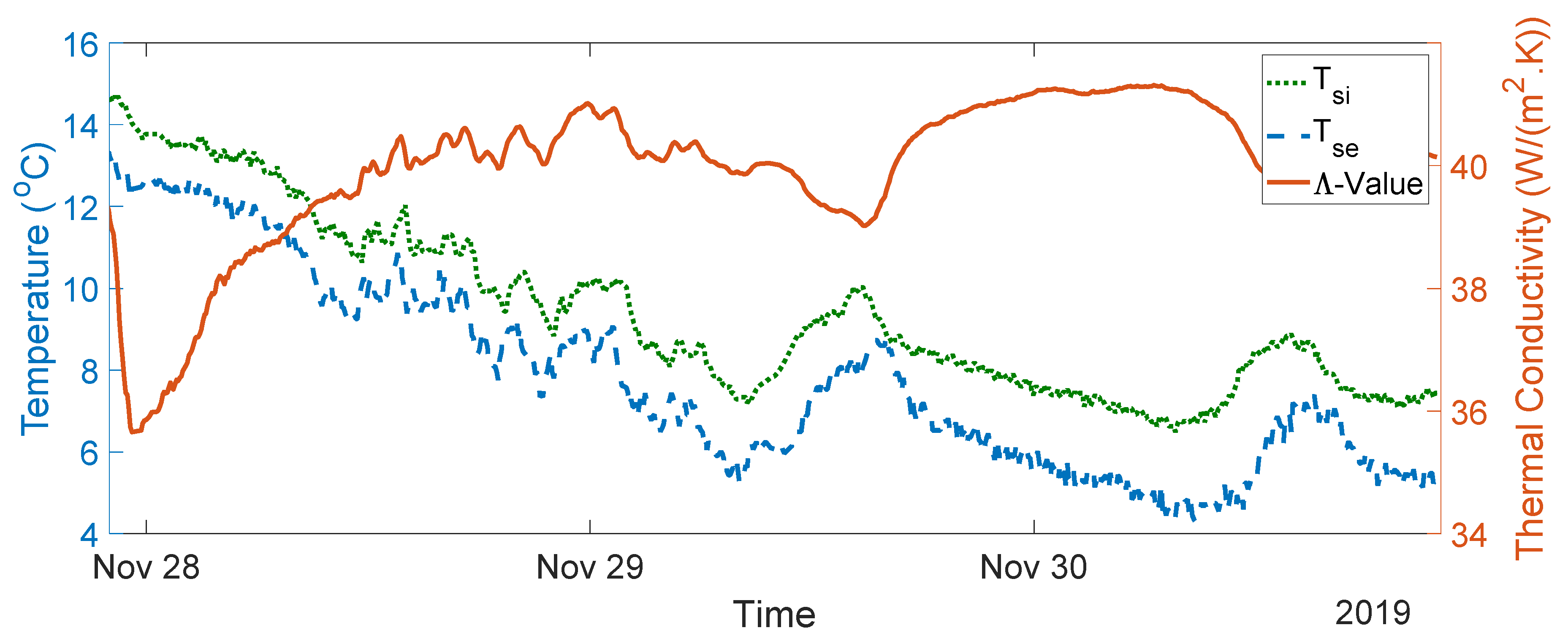
| Measurement Period (Day) | Typical U-Value (W/m2K) [22,23] | U-Value Measurement (W/m2K) | Average U-Value Measurement (W/m2K) |
|---|---|---|---|
| 1–3 | 4.8–5.8 | 4.56–4.86, see Figure 6 | 4.82 |
| 2–4 | 4.55–4.78, see Figure 7 | 4.75 | |
| 3–5 | 4.55–4.65, see Figure 8 | 4.65 | |
| 4–6 | 4.64–4.79, see Figure 9 | 4.75 | |
| 5–7 | 4.55–5.11, see Figure 10 | 4.85 |
© 2020 by the authors. Licensee MDPI, Basel, Switzerland. This article is an open access article distributed under the terms and conditions of the Creative Commons Attribution (CC BY) license (http://creativecommons.org/licenses/by/4.0/).
Share and Cite
Lihakanga, R.; Ding, Y.; Medero, G.M.; Chapman, S.; Goussetis, G. A High-Resolution Open Source Platform for Building Envelope Thermal Performance Assessment Using a Wireless Sensor Network. Sensors 2020, 20, 1755. https://doi.org/10.3390/s20061755
Lihakanga R, Ding Y, Medero GM, Chapman S, Goussetis G. A High-Resolution Open Source Platform for Building Envelope Thermal Performance Assessment Using a Wireless Sensor Network. Sensors. 2020; 20(6):1755. https://doi.org/10.3390/s20061755
Chicago/Turabian StyleLihakanga, Romwald, Yuan Ding, Gabriela M. Medero, Samuel Chapman, and George Goussetis. 2020. "A High-Resolution Open Source Platform for Building Envelope Thermal Performance Assessment Using a Wireless Sensor Network" Sensors 20, no. 6: 1755. https://doi.org/10.3390/s20061755
APA StyleLihakanga, R., Ding, Y., Medero, G. M., Chapman, S., & Goussetis, G. (2020). A High-Resolution Open Source Platform for Building Envelope Thermal Performance Assessment Using a Wireless Sensor Network. Sensors, 20(6), 1755. https://doi.org/10.3390/s20061755





